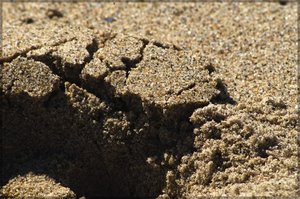Sand
|
|

Sand is an example of a class of materials called granular matter. Sand is a naturally occurring, finely divided rock, comprising particles or granules ranging in size from 0.063 to 2 mm. An individual particle in this range size is termed a sand grain. The next smaller size class in geology is silt: particles below 0.063 mm down to 0.004 mm in size. The next larger size class above sand is gravel, with particles ranging up to 64 mm (see grain size for standards in use).
The most common constituent of sand in inland continental settings and non-tropical coastal settings, is silica (silicon dioxide), usually in the form of quartz because of the considerable hardness of this mineral. However, the composition of sand varies according to local rock sources and conditions. The bright white sands found in tropical and subtropical coastal settings is ground-up limestone. Arkose is a sand or sandstone with considerable feldspar content which is derived from the weathering and erosion of a usually nearby granite. Some locations have sands that contain magnetite, chlorite, glauconite, or gypsum. Sands rich in magnetite are dark to black in color, as are sands derived from volcanic basalts. The chlorite-glauconite bearing sands are typically green in color, as are sands derived from basalts (lavas) with a high olivine content. The gypsum sand dunes of the White Sands National Monument in New Mexico are famous for their bright, white color. Sand deposits in some areas contain garnets and other resistant minerals, including some small gemstones.
Sand is transported by wind or water and deposited in the form of beaches, dunes, sand spits, sand bars, and the like. In a desert, sand is a dominant constituent of the soil.
The study of sand is called arenology.
Uses of sand
Sand is often a principal component of the aggregate used in the preparation of concrete. Sand manufactured at rock crusher plants for use as an aggregate is called mansand. Graded sand is used as an abrasive in sandblasting and is also used in media filters for filtering water.
Sandy soils are ideal for certain crops such as watermelons and peanuts and are often preferred for intensive dairy farming because of their excellent drainage characteristics.
Sand bags are used for protection against floods and gun fire. They can be easily transported when empty, and filled with local sand.
People, especially children, love to play with sand on a beach or in a sandbox. See sand art and play for details.
Hazards of sand
Bags of sand now typically carry labels warning the user to wear respiratory protection and avoid breathing the fine silica dust. There have been a number of lawsuits in recent years where workers have sought damages after they developed silicosis, a lung disease caused by inhalation of fine silica particles.
People have been severely injured and even killed after digging sand "caves" in large dunes, sandhills, or even on beaches when the cave or tunnel collapsed upon them.

